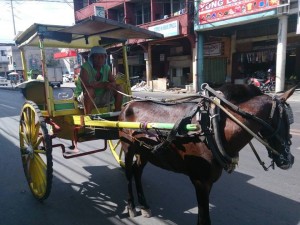‘Kutseros’ keep horse carriages alive in city

Amado Abatayo and his horse “Carlo” wait for passengers at Duljo-Fatima, Cebu City. (CDN PHOTO/ BJORN TABANERA)
The day finds 60-year-old Amado Abatayo maneuvering his tartanilla pulled by Carlo, a silky brown horse along side streets of downtown Cebu City.
Standing a little over 5 feet, Abatayo still possesses much energy and vigor as a kutsero.
Abatayo said he takes home P300 to P450 a day after paying P150 as rent for the horse. He lives at the horse’s owner Michael Cabatino’s home in barangay Duljo Fatima on weekdays.
By 7 a.m., Abatayo rises to feed grass locally known as balili to Carlo, his first horse, then tends to his second horse, Ginggon.
His wife sells vegetables in the market to supplement their family’s income, just enough to get by with one child to support.
For over three decades, the tartanilla route has been a Cebu city mainstay.
When he moved from his hometown in Bohol to Cebu at age 20 in search of a better life , he wanted to be more than a construction worker. Five years later, a friend introduced him to the life of a kutsero.
The migrant’s pattern was followed by Floren Cañete, a younger kutsero.
Born in Tubigon, Bohol, Cañete was 17 when he moved to Cebu and followed in his father’s footsteps, becoming a kutsero like his older brother.
The tartanillas (called calesas in Luzon) in Bohol are no longer as sturdy as those in Cebu City, said Cañete, who takes care of a mare named Rose.
Riding horse carriages was the main transport mode in pre-war Cebu, but their number has dwindled.
Tartanilla routes in Cebu City serve side streets of Colon from Carbon market to Duljo, and Duljo to Tabuan at 6 pesos a ride with four passengers seated in the carriage.
Asked what would happen if fewer people want to ride his tartanilla in the coming years, Abatayo remains hopeful.
“Paminaw nako, dili ni mawala. Dugay na mani gud. Mao na jud ni ba,” he says (I think the tartanilla will not disappear. It’s been around so long and is here to stay.)
With motorized choices like tricycles, habal-habal motorbikes and jeepneys, not to mention the pedal-pushing trisikad, why do some people still prefer riding kalesas?
His colleague, Cañete, said the slow trotting provides a unique experience. Some people just like horses. Maybe they enjoy watching the scenery on a carriage ride. They feel like they’re being rocked in a cradle.
Disclaimer: The comments uploaded on this site do not necessarily represent or reflect the views of management and owner of Cebudailynews. We reserve the right to exclude comments that we deem to be inconsistent with our editorial standards.
